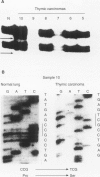Abstract
Thymic epithelial tumours are broadly classified into thymomas and thymic carcinomas. Although both tumours occasionally show invasive growth, they exhibit different clinical and biological findings. The oncogene and anti-oncogene in thymic epithelial tumours have not been evaluated fully. We investigated the expression of p53 protein by immunohistochemical analysis using the anti-p53 polyclonal antibody (CM-1) in 17 thymomas and 19 thymic carcinomas. We also examined p53 gene (exon 5-8) mutation in 18 thymic carcinomas by using polymerase chain reaction-single-strand conformation polymorphism methods and direct sequencing. Of the thymoma cases, only one invasive thymoma showed focal nuclear staining. Fourteen of the 19 thymic carcinomas (74%) showed nuclear staining. Point mutations of the p53 gene were recognized in only 2 of the 18 thymic carcinomas (11%). One was the mutation C to T transition in the first letter of codon 222 in exon 6, which results in the amino acid substitution from proline to serine. Another was a silent mutation. p53 protein accumulation is highly frequent in thymic carcinomas but not in thymomas, and gene mutation is uncommon in thymic carcinomas.
Full text
PDF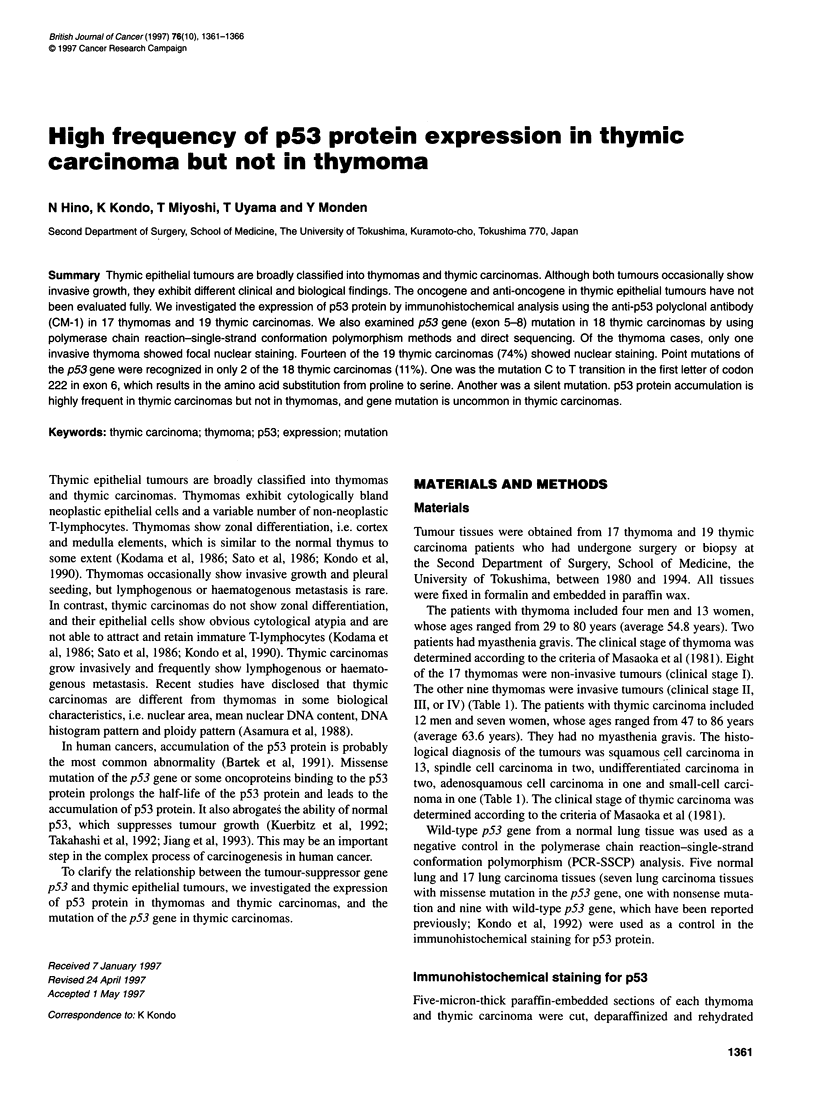
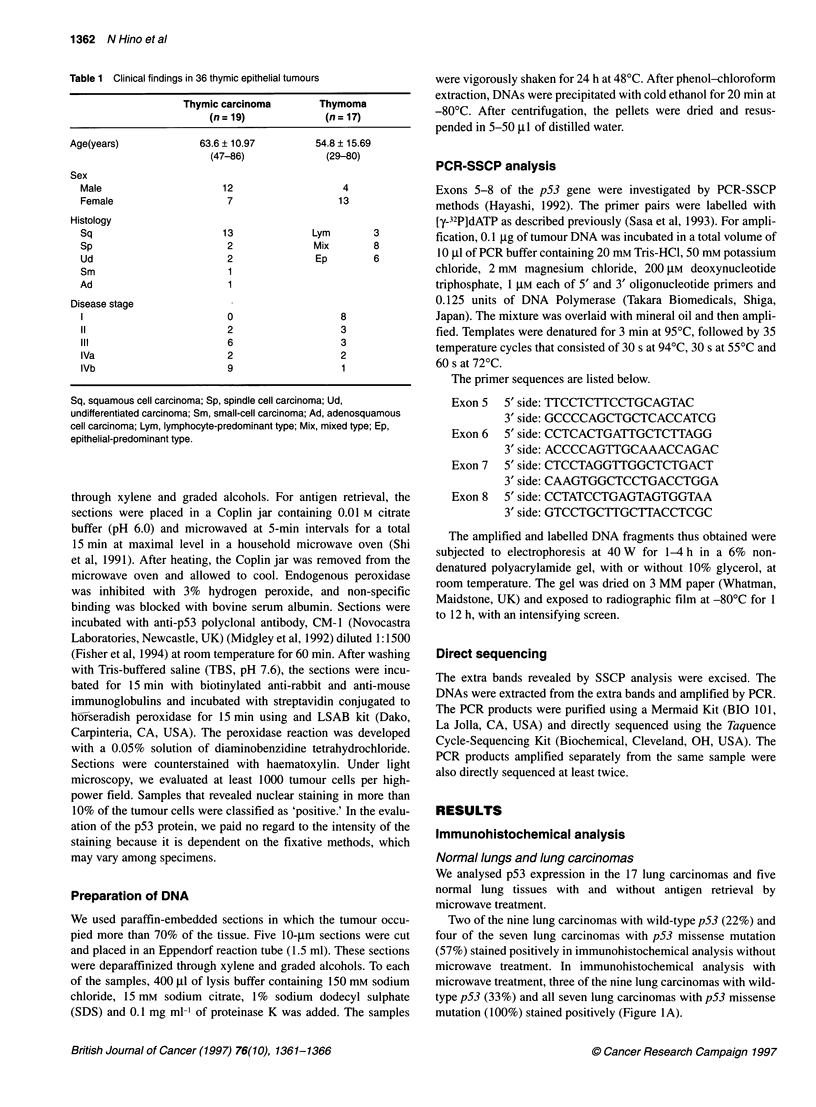
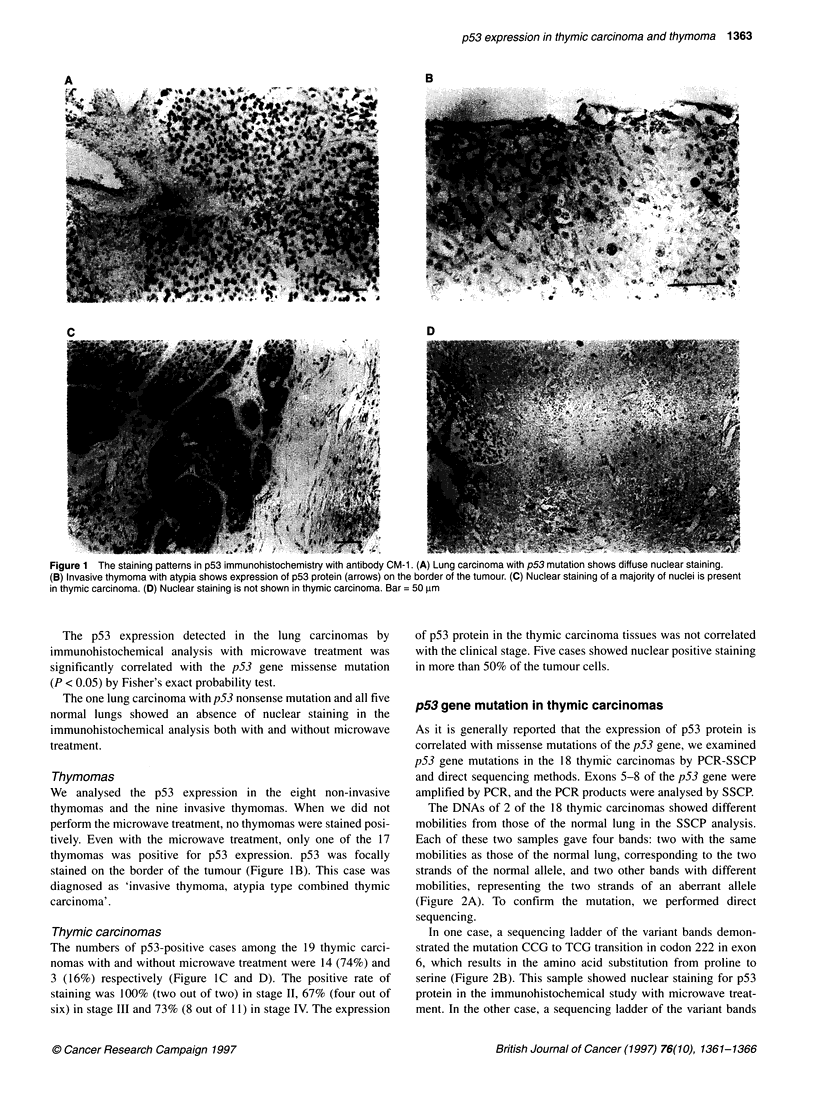
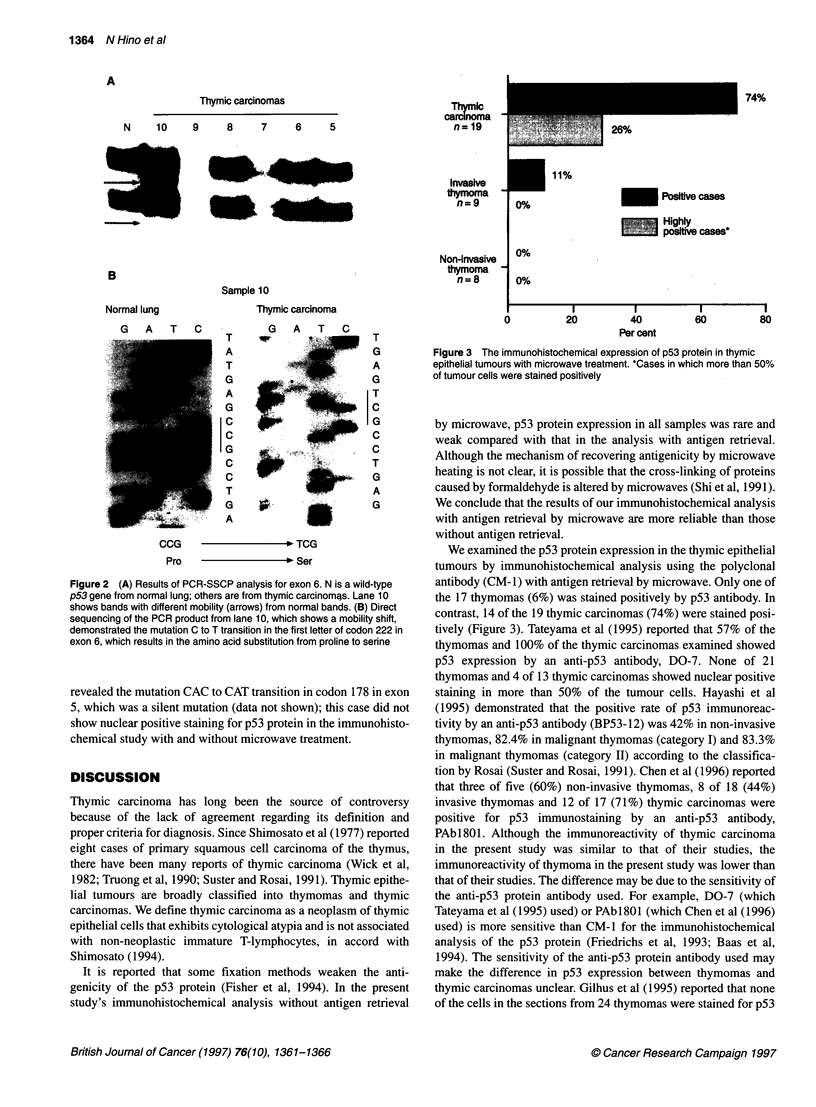
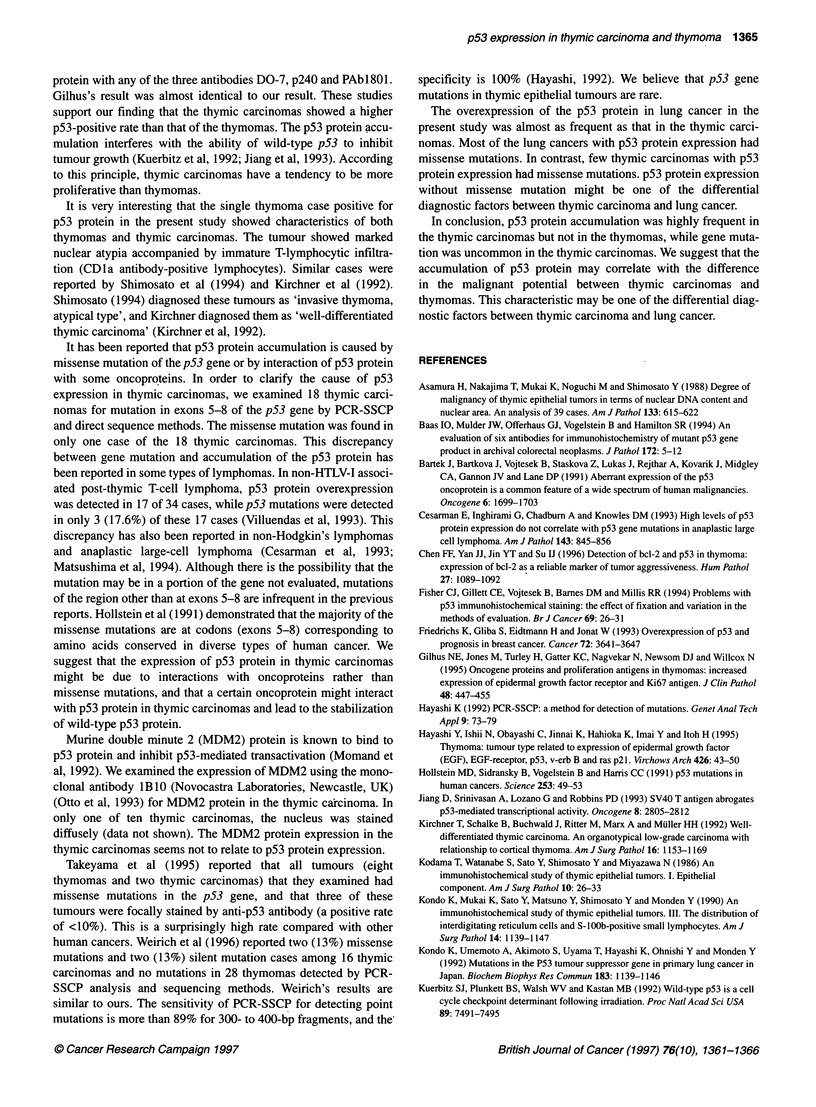
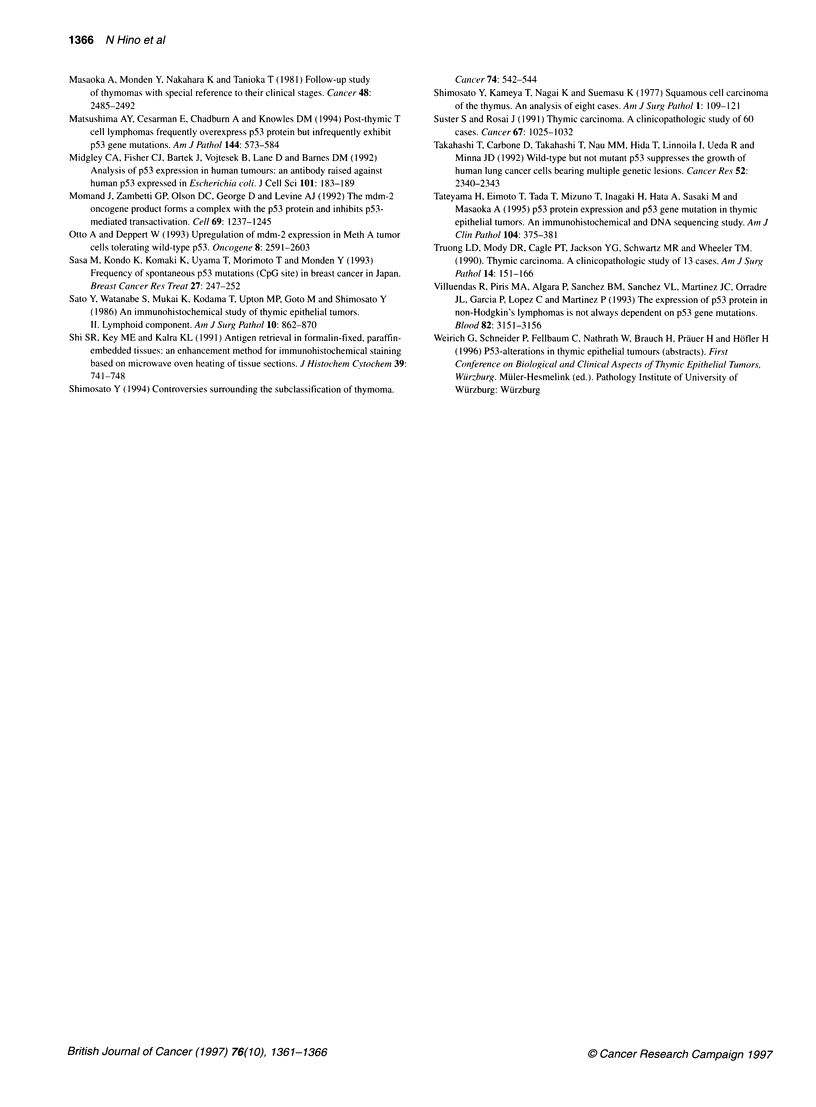
Images in this article
Selected References
These references are in PubMed. This may not be the complete list of references from this article.
- Asamura H., Nakajima T., Mukai K., Noguchi M., Shimosato Y. Degree of malignancy of thymic epithelial tumors in terms of nuclear DNA content and nuclear area. An analysis of 39 cases. Am J Pathol. 1988 Dec;133(3):615–622. [PMC free article] [PubMed] [Google Scholar]
- Baas I. O., Mulder J. W., Offerhaus G. J., Vogelstein B., Hamilton S. R. An evaluation of six antibodies for immunohistochemistry of mutant p53 gene product in archival colorectal neoplasms. J Pathol. 1994 Jan;172(1):5–12. doi: 10.1002/path.1711720104. [DOI] [PubMed] [Google Scholar]
- Bártek J., Bártková J., Vojtesek B., Stasková Z., Lukás J., Rejthar A., Kovarík J., Midgley C. A., Gannon J. V., Lane D. P. Aberrant expression of the p53 oncoprotein is a common feature of a wide spectrum of human malignancies. Oncogene. 1991 Sep;6(9):1699–1703. [PubMed] [Google Scholar]
- Cesarman E., Inghirami G., Chadburn A., Knowles D. M. High levels of p53 protein expression do not correlate with p53 gene mutations in anaplastic large cell lymphoma. Am J Pathol. 1993 Sep;143(3):845–856. [PMC free article] [PubMed] [Google Scholar]
- Chen F. F., Yan J. J., Jin Y. T., Su I. J. Detection of bcl-2 and p53 in thymoma: expression of bcl-2 as a reliable marker of tumor aggressiveness. Hum Pathol. 1996 Oct;27(10):1089–1092. doi: 10.1016/s0046-8177(96)90289-0. [DOI] [PubMed] [Google Scholar]
- Fisher C. J., Gillett C. E., Vojtesek B., Barnes D. M., Millis R. R. Problems with p53 immunohistochemical staining: the effect of fixation and variation in the methods of evaluation. Br J Cancer. 1994 Jan;69(1):26–31. doi: 10.1038/bjc.1994.4. [DOI] [PMC free article] [PubMed] [Google Scholar]
- Friedrichs K., Gluba S., Eidtmann H., Jonat W. Overexpression of p53 and prognosis in breast cancer. Cancer. 1993 Dec 15;72(12):3641–3647. doi: 10.1002/1097-0142(19931215)72:12<3641::aid-cncr2820721215>3.0.co;2-8. [DOI] [PubMed] [Google Scholar]
- Gilhus N. E., Jones M., Turley H., Gatter K. C., Nagvekar N., Newsom-Davis J., Willcox N. Oncogene proteins and proliferation antigens in thymomas: increased expression of epidermal growth factor receptor and Ki67 antigen. J Clin Pathol. 1995 May;48(5):447–455. doi: 10.1136/jcp.48.5.447. [DOI] [PMC free article] [PubMed] [Google Scholar]
- Hayashi K. PCR-SSCP: a method for detection of mutations. Genet Anal Tech Appl. 1992 Jun;9(3):73–79. doi: 10.1016/1050-3862(92)90001-l. [DOI] [PubMed] [Google Scholar]
- Hayashi Y., Ishii N., Obayashi C., Jinnai K., Hanioka K., Imai Y., Itoh H. Thymoma: tumour type related to expression of epidermal growth factor (EGF), EGF-receptor, p53, v-erb B and ras p21. Virchows Arch. 1995;426(1):43–50. doi: 10.1007/BF00194697. [DOI] [PubMed] [Google Scholar]
- Hollstein M., Sidransky D., Vogelstein B., Harris C. C. p53 mutations in human cancers. Science. 1991 Jul 5;253(5015):49–53. doi: 10.1126/science.1905840. [DOI] [PubMed] [Google Scholar]
- Jiang D., Srinivasan A., Lozano G., Robbins P. D. SV40 T antigen abrogates p53-mediated transcriptional activity. Oncogene. 1993 Oct;8(10):2805–2812. [PubMed] [Google Scholar]
- Kirchner T., Schalke B., Buchwald J., Ritter M., Marx A., Müller-Hermelink H. K. Well-differentiated thymic carcinoma. An organotypical low-grade carcinoma with relationship to cortical thymoma. Am J Surg Pathol. 1992 Dec;16(12):1153–1169. [PubMed] [Google Scholar]
- Kodama T., Watanabe S., Sato Y., Shimosato Y., Miyazawa N. An immunohistochemical study of thymic epithelial tumors. I. Epithelial component. Am J Surg Pathol. 1986 Jan;10(1):26–33. doi: 10.1097/00000478-198601000-00004. [DOI] [PubMed] [Google Scholar]
- Kondo K., Mukai K., Sato Y., Matsuno Y., Shimosato Y., Monden Y. An immunohistochemical study of thymic epithelial tumors. III. The distribution of interdigitating reticulum cells and S-100 beta-positive small lymphocytes. Am J Surg Pathol. 1990 Dec;14(12):1139–1147. [PubMed] [Google Scholar]
- Kondo K., Umemoto A., Akimoto S., Uyama T., Hayashi K., Ohnishi Y., Monden Y. Mutations in the P53 tumour suppressor gene in primary lung cancer in Japan. Biochem Biophys Res Commun. 1992 Mar 31;183(3):1139–1146. doi: 10.1016/s0006-291x(05)80309-2. [DOI] [PubMed] [Google Scholar]
- Kuerbitz S. J., Plunkett B. S., Walsh W. V., Kastan M. B. Wild-type p53 is a cell cycle checkpoint determinant following irradiation. Proc Natl Acad Sci U S A. 1992 Aug 15;89(16):7491–7495. doi: 10.1073/pnas.89.16.7491. [DOI] [PMC free article] [PubMed] [Google Scholar]
- Masaoka A., Monden Y., Nakahara K., Tanioka T. Follow-up study of thymomas with special reference to their clinical stages. Cancer. 1981 Dec 1;48(11):2485–2492. doi: 10.1002/1097-0142(19811201)48:11<2485::aid-cncr2820481123>3.0.co;2-r. [DOI] [PubMed] [Google Scholar]
- Matsushima A. Y., Cesarman E., Chadburn A., Knowles D. M. Post-thymic T cell lymphomas frequently overexpress p53 protein but infrequently exhibit p53 gene mutations. Am J Pathol. 1994 Mar;144(3):573–584. [PMC free article] [PubMed] [Google Scholar]
- Midgley C. A., Fisher C. J., Bártek J., Vojtesek B., Lane D., Barnes D. M. Analysis of p53 expression in human tumours: an antibody raised against human p53 expressed in Escherichia coli. J Cell Sci. 1992 Jan;101(Pt 1):183–189. doi: 10.1242/jcs.101.1.183. [DOI] [PubMed] [Google Scholar]
- Momand J., Zambetti G. P., Olson D. C., George D., Levine A. J. The mdm-2 oncogene product forms a complex with the p53 protein and inhibits p53-mediated transactivation. Cell. 1992 Jun 26;69(7):1237–1245. doi: 10.1016/0092-8674(92)90644-r. [DOI] [PubMed] [Google Scholar]
- Otto A., Deppert W. Upregulation of mdm-2 expression in Meth A tumor cells tolerating wild-type p53. Oncogene. 1993 Sep;8(9):2591–2603. [PubMed] [Google Scholar]
- Sasa M., Kondo K., Komaki K., Uyama T., Morimoto T., Monden Y. Frequency of spontaneous p53 mutations (CpG site) in breast cancer in Japan. Breast Cancer Res Treat. 1993 Sep;27(3):247–252. doi: 10.1007/BF00665694. [DOI] [PubMed] [Google Scholar]
- Sato Y., Watanabe S., Mukai K., Kodama T., Upton M. P., Goto M., Shimosato Y. An immunohistochemical study of thymic epithelial tumors. II. Lymphoid component. Am J Surg Pathol. 1986 Dec;10(12):862–870. doi: 10.1097/00000478-198612000-00005. [DOI] [PubMed] [Google Scholar]
- Shi S. R., Key M. E., Kalra K. L. Antigen retrieval in formalin-fixed, paraffin-embedded tissues: an enhancement method for immunohistochemical staining based on microwave oven heating of tissue sections. J Histochem Cytochem. 1991 Jun;39(6):741–748. doi: 10.1177/39.6.1709656. [DOI] [PubMed] [Google Scholar]
- Shimosato Y. Controversies surrounding the subclassification of thymoma. Cancer. 1994 Jul 15;74(2):542–544. doi: 10.1002/1097-0142(19940715)74:2<542::aid-cncr2820740203>3.0.co;2-1. [DOI] [PubMed] [Google Scholar]
- Shimosato Y., Kameya T., Nagai K., Suemasu K. Squamous cell carcinoma of the thymus. An analysis of eight cases. Am J Surg Pathol. 1977 Jun;1(2):109–121. doi: 10.1097/00000478-197706000-00002. [DOI] [PubMed] [Google Scholar]
- Suster S., Rosai J. Thymic carcinoma. A clinicopathologic study of 60 cases. Cancer. 1991 Feb 15;67(4):1025–1032. doi: 10.1002/1097-0142(19910215)67:4<1025::aid-cncr2820670427>3.0.co;2-f. [DOI] [PubMed] [Google Scholar]
- Takahashi T., Carbone D., Takahashi T., Nau M. M., Hida T., Linnoila I., Ueda R., Minna J. D. Wild-type but not mutant p53 suppresses the growth of human lung cancer cells bearing multiple genetic lesions. Cancer Res. 1992 Apr 15;52(8):2340–2343. [PubMed] [Google Scholar]
- Tateyama H., Eimoto T., Tada T., Mizuno T., Inagaki H., Hata A., Sasaki M., Masaoka A. p53 protein expression and p53 gene mutation in thymic epithelial tumors. An immunohistochemical and DNA sequencing study. Am J Clin Pathol. 1995 Oct;104(4):375–381. doi: 10.1093/ajcp/104.4.375. [DOI] [PubMed] [Google Scholar]
- Truong L. D., Mody D. R., Cagle P. T., Jackson-York G. L., Schwartz M. R., Wheeler T. M. Thymic carcinoma. A clinicopathologic study of 13 cases. Am J Surg Pathol. 1990 Feb;14(2):151–166. doi: 10.1097/00000478-199002000-00007. [DOI] [PubMed] [Google Scholar]
- Villuendas R., Piris M. A., Algara P., Sánchez-Beato M., Sánchez-Verde L., Martinez J. C., Orradre J. L., García P., Lopez C., Martinez P. The expression of p53 protein in non-Hodgkin's lymphomas is not always dependent on p53 gene mutations. Blood. 1993 Nov 15;82(10):3151–3156. [PubMed] [Google Scholar]




